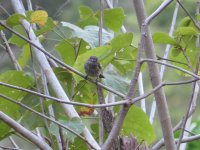Richard Klim
-------------------------
Princeton University, 24 Nov 2014: New Bird Species Confirmed 15 Years After First Observation.Undescribed: Muscicapoidea: Some hidden taxa:...
The “Lore Lindu Flycatcher” Muscicapa sp in Indonesia: Sulawesi: Lore Lindu National Park (Ben King & al. in 1997)
Harris, Rasmussen, Yong, Prawiradilaga, Putra, Round & Rheindt 2014. A new species of Muscicapa flycatcher from Sulawesi, Indonesia. PLoS ONE 9(11): e112657. [article] [pdf]
- Muscicapa sodhii, sp. nov.
www.worldbirdnames.org/updates/update-diary/
www.worldbirdnames.org/updates/proposed-splits/
2014 Nov 24: Post newly described Sulawesi Streaked Flycatcher on Updates/PS
Last edited:





